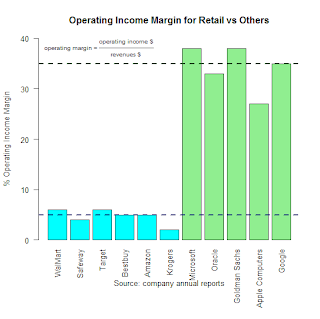Retailing has been a big part of economies for a long time now. It has evolved considerably in the last 2000 years, starting out as simple services, to organized marketplaces, to sophisticated supply-chain and logistics (the silk route, ocean voyages etc). Apart from the historical context, most modern societies rely upon retailing for survival. We do not produce all of our requirements and have to rely upon retailing to satisfy various needs starting from food, clothing, banking etc.
Retailing is pretty big, making p somewhere between 15%-30% of the total GDP in the US (and comparable in other first world countries). The higher end estimate includes traditional retailers, food and food service providers, and motor and motor vehicle parts providers. Growth of each the major retail components along with the economy is displayed below.
 |
| Retail and GDP growth in US, copyright |
How has retailing evolved over the ages?
The earliest markets (or trades) developed based upon the barter system and then evolved to using silver or gold rings, bars, and coins. Introduction of money changes markets and trading forever, leading to new institutions and ways of managing money (banking system, insurance system, shares and public markets, now the Wall Street)
They were frequently located at convenient locations such as the town centers or near the coast to allow for easy and quick service.
Many of these older characteristics do persist in various markets in the world today.
The department stores as we know them originated in the 19th century. The earliest reference I could find is for the LE Bon Marche in Paris and John Lewis Newcastle (Bainbridge) department store founded in England, both opened in 1838.
| Traditional Fish Market source |
Retailing appears to be a mundane area, but it is full of innovation and evolution. As a result modern day retailing presents a very different look and behavior in terms of cost structure, service model, and assortment breadth. In terms of near term evolution, retailing was a dominated by independent stores and merchants, at most housed in a common facility to aid trade. This gave rise to specialization in terms of producers, transporters, wholesellers/traders, consumer outlets.
In the last 50 years or so the landscape underwent more transformations and we started seeing chains of retail outlet spread out over large geographical areas. Some examples have become Iconic -- WalMart, Krogers etc.
Over time, these chains started becoming specialized and focused on certain areas (now referred to as verticals) -- grocery, drugstores, mass merchandisers, apparel, shoes, furniture, kitchen, sports and outdoors, children and toys, electronics and entertainment etc
How has internet influenced retailing?
Finally, with internet explosion, we see a new breed of retailers -- e-tailers. This gave a new opportunity to the independent retailers because of the low barriers to entry (setting up a website is a lot cheaper than a physical store) and the advantage of using technology for improved productivity. Slowly most brick and mortar retailers are catching up on this front and have a significant presence on the web. However, only a tiny amount of their total business is due to e-tailing. Consequently, they are not the innovators.
Amazon has been the trailblazer in this area starting out really early (1996?) with selling books. Their revenues for year 2009 at $24B represents a very high and sustained growth rate since their founding. There are many other fine examples in this area:
Zappos.com: The pioneering shoe retailer acquired by Amazon.com in 2009 for close to $1B.
Overstock.com: Operating as a big clearing house for the surpluses through the internet channel
Newegg/TigerDirect: Started out as specialty outlets that have now grown considerably to provide a wide range of products and services within the electronics and appliances sector
The end result of this evolution means that retailing landscape is extremely competitive. Operating margins for retailers are usually low (typically around 5%) compared to other sectors such as finance and software (25% or higher).
 |
| Operating Margins of Retailers vs Others. copyright |
Stiff competition means that relatively small advantages lead to growth vs perishment. During each business cycle, a number of retail chains have collapsed, to be replaced in many cases with new entrants. The 800 pound gorilla dominating the landscape is, of course, Walmart. Almost every retailer needs to compete against Walmart for survival, which leads to very interesting strategies by the different retailers.
WalMart usually comes to dominate each of the segment that they enter wiping out much of their competition. That happened to the music stores (Tower Records etc) when WalMart and other stores started carrying music. Best Buy and WalMart played a big part in the demise of Circuit city.
To their credit, WalMart has revolutionized the global supply chain and distribution network. I consider that as another milestone in the retailing evolution.
How are social networking, web 2.0 influencing retailing?
With the continued evolution in the web technologies, a new type of channel and product assortment is being introduced. Electronic goods and virtual items. Apple itunes represents the biggest success story with the sale of music and custom applications. Internet games such as Farmville, virtual-life setups such as secondlife, video game communities connected by internet (xbox, wii, etc) allows people to buy completely virtual goods with the real money (Farmville revenues are in excess of $100MM).
Finally, the recent popularity of social networking is spawning a new breed of enablers: Woot.com, groupon.com, gilt.com etc that allow for the experience of collective and social buying.We will look at this area in more detail in a future post.
Next, we will explore each of the retailing verticals in detail.